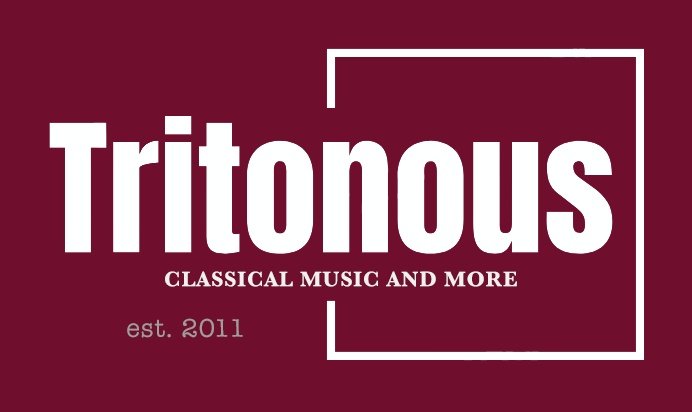
This is core repertoire, so it needs to be special. It is.
For his ninth recording with Decca (he signed in 2011, when he became the youngest British musician and the first British pianist in over sixty years to join the label), Benjamin Grosvenor has chosen Chopin’s two great piano sonatas. You will not be disappointed in any way, shape or form, but before we go on, I would like to make one small point. I know the Piano Sonata No. 1 is of another level, is earlier, and so on. But there is a fine case to be made for this piece, and it would be good to have Grosvenor play Sonatas Nos. 1-3 on one disc. Maybe he could issue a disc of lesser-known Chopin?
As it is, he enters a vast and crowded recorded space.
In Grosvenor’s own words,
The brooding Second Sonata is widely known for its Funeral March, but it also shows Chopin as a trailblazer, with the Finale (Presto) hinting at modernism. It stands out in Chopin’s work as something truly unique.
Gosvenor’s playing is stunning in its melding of structural awareness and lyricism. He knows just how much to bend; his relain between got and left hand (and the detail in the leftest) is superb. He does make the development sound truly exploratory and even modern, as if we are in the area of late Chopin almost:
Contrasts in the Scherzo are marked. Grosvenor’s range of sound is huge but he never breaks the sound of his instrument. Again, it is detail that holds the key her: Listen to the detail we can hear in the left-hand of the Trio, including voice-leading that links phrases beautifully. Just one small caveat in that Trio – some of the left-hand descents display rubato that is just a touch of the studio. And yet he brings the fire of live performance to the outer sections. Grosvenor’s repeated notes in the Scherzo generate energy perfectly (they can all too easily sound like a woodpecker in the wrong hands):
Again, listen to the voice-leading in the famous ‘Funeral March’; and to how the ‘shaft of light’ theme works so beautiful (Uchida remains supreme here, but how carefully Grosvenor sculpts the melody, the rubato here perfect):
The ‘wind amongst he gravestones’ finale is impetuous, the perfect ending to Chopin’s fascinating take on what a sonata is, or can be.
The central three works (Opp. 57, 23 and 55) act as a micro-unit within themselves.A lyrical, beautiful Berceuse acts as a calming plateau, the right-hand roulades a joy. Rarely has Bellini’s influence on Chopin been as clear: this is a true song.
Of this Op. 57 Berceuse, Gosveno says,
Among the weightier works on this album, I included the Berceuse to offer a moment of calm. It’s a beautiful piece written in the same year as the Third Sonata, with work on it beginning during a romantic summer at Nohant. In just a few years, Chopin had established himself as one of the greatest composers for the piano.
There’s an ‘Official Music Video’ for this:
After the ever-increasing decorations of the Berceuse, the First Ballade is brooding and intense, seething, its coda markedly more nuanced than many but at no expense to velocity:
The two Nocturnes of Op. 55 complete the central pillar of the recital. The first is the F-Minor, which begins innocently enough, its melody simply yet heart -breaking. But the decorations increase as the piece progresses, the final, high roulades a miracle. The triplet octaves are perfectly contrastive, too – Grosvenor makes this into a mini-tone poem, just as impactful as the Ballade:
The harmonic sophistications of Op. 55 No. 2 (E flat-Major) are immediate, the perfect counterweight.
The Third Sonata, written at the height of Chopin’s career in 1844, offer different challenges for the second: it’s finale, in particular, is very different, cumulative rather than an almost Impressionoist painting.
The expansive first movement is judged just right, passage of interior musing always implying a need to expand into grad statement. Again, Grosvenor’s awareness of linear writing is miraculous; he realises fully Chopin’s debt to Bach:
There’s an ‘Official Music Video’ of the Scherzo here, playing of legerdemain, crystal clarity and sonic beauty:
The Lento here balances the expansive first movement, durations nearly aligned. The movement sort of uncoils in Grosvenor’s interpretation:
Grosvenor’s way with the finale is more variegated in articulation than ,most Unafaid of staccato, he makes it feels eminently unsettled. Again, that sense of terracing, of voices unheard now speaking in perfect accord. This is real technique: not the velocity, but the awareness of Chopin’s intent, of the cumulative energy that leads to the fully satisfying close.
The recording quality, too, is of the finest (Garsington was the venue!). A stunning release.
This latest release follows Grosvenor’s much-lauded 2020 recording of the Chopin piano concerti with Elim Chan and the Royal Scottish National Orchestra (Classical Explorer post), which received the Gramophone Concerto Award and a Diapason d’Or de l’Année.
Don’t forget, oo, we have previously lauded Grosvenor’s Liszt, music by the Schumnns (Robert & Clara), plus a Wigmore Hall recital of Brett Dean, Bach & Brahms and a 2023 Proms recital of Debussy, Liszt and Ravel.
Decca provided some info about Grosvenor’s cavities, reproduced below:
Grosvenor continues to garner widespread acclaim. Recent highlights include debuts with the Bamberg Symphony and NHK Symphony Orchestras, and performances with the London Philharmonic Orchestra conducted by Andrey Boreyko. A favourite at the BBC Proms, he returns this summer to perform Ravel’s Piano Concerto in G major at the Royal Albert Hall (15 August). Other engagements this season include recitals at the Chipping Campden Music Festival (23 May), Wigmore Hall in London (24 May), Konzerthaus Berlin as part of the Berlin Klavierfestival (27 May), Casa da Música in Porto (28 May), PHIL Haarlem (30 May), Musis & Stadstheater Arnhem (31 May), and La Vague Classique Festival (3 June). On 14 June, he joins the Royal Northern Sinfonia at The Glasshouse International Centre for Music to perform Shostakovich’s Piano Concerto No. 1 with conductor Dinis Sousa, and later appears at the Risør Chamber Music Festival in Norway (24–29 June).
Live dates:
- 15 August 2025 – BBC Proms: Benjamin Grosvenor Plays Ravel
During the 2024/2025 season Benjamin makes his debut with the NHK Symphony/Paavo Jarvi, Bamberger Symphoniker and Dallas Symphony Orchestras. Benjamin also returns to Boston/Andris Nelsons, Montreal and Bern Symphony Orchestras and plays a UK tour with the London Philharmonic Orchestra and Andrey Boreyko. As a featured artist at the Théâtre des Champs-Elysées in Paris, he performs with both orchestra and in solo recital. Other recital performances this season include Tokyo, Shanghai, Berlin and the Wigmore Hall in London.
Grosvenor is an Ambassador of Music Masters, a charity dedicated to making music education accessible to all children regardless of their background; championing diversity and inclusion.
You can purchase this wonderful Chopin disc at Amazon here; it seems to be going well, as at the time of writing there are only eight left in stock! Streaming below.





%202025%20©%20Mark%20Douet.jpg?w=670&resize=670,446&ssl=1)



